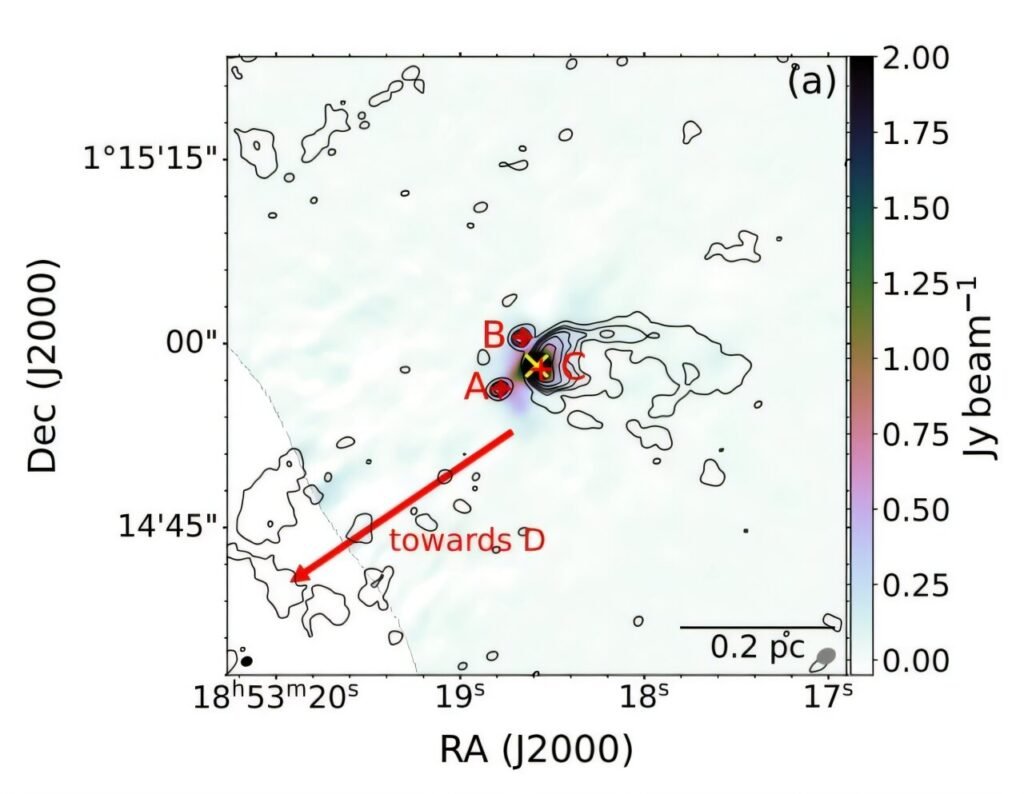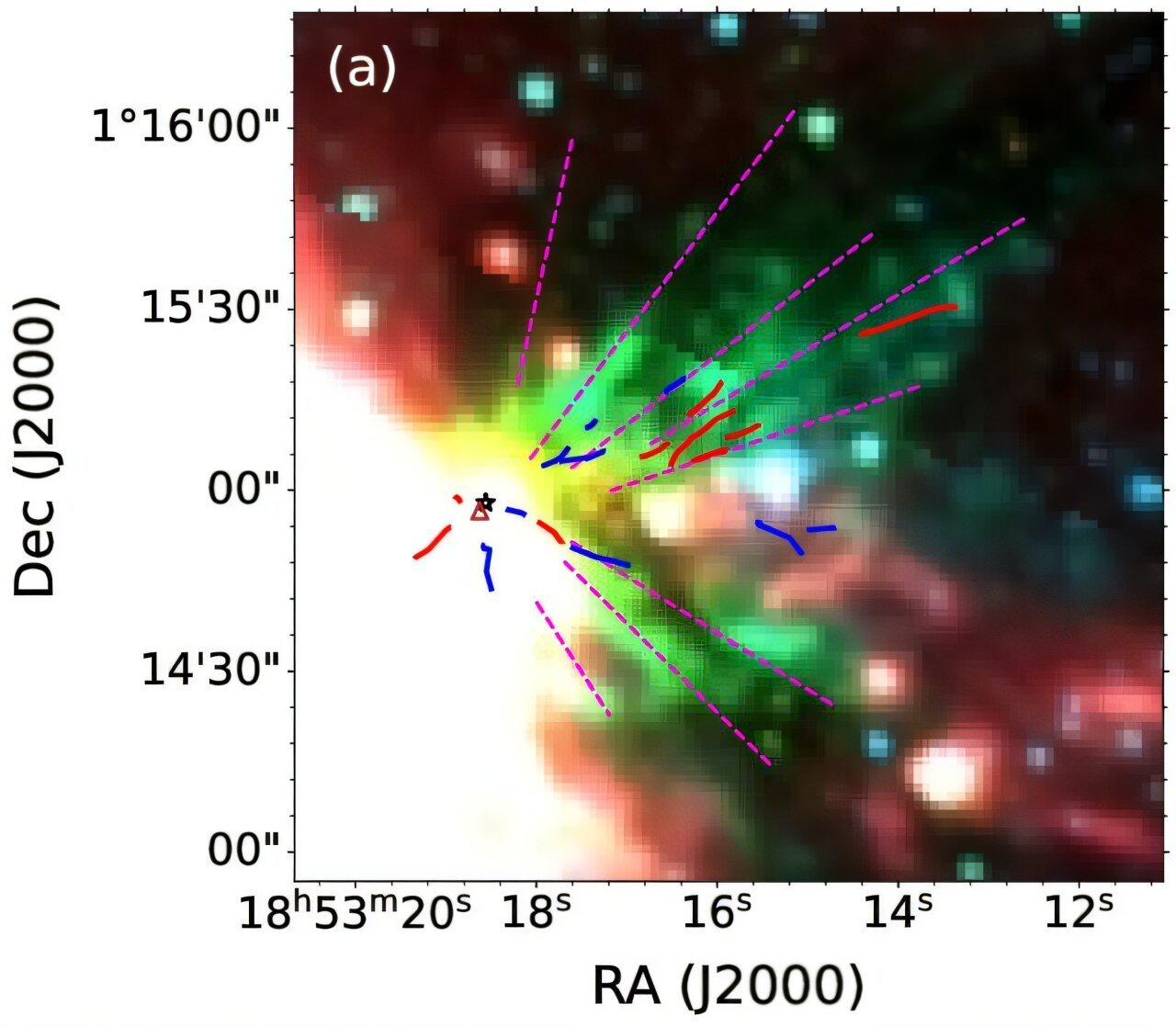High above the dusty Chilean desert of Atacama, nestled among the eerie silence and razor-sharp skies, the Atacama Large Millimeter/submillimeter Array—ALMA—quietly listens to the whispers of the cosmos. Its radio antennas peer deep into molecular clouds, seeking the secrets of star birth and cosmic evolution. Now, from an enigmatic region known as G34.26+0.15, ALMA has uncovered something extraordinary: a violent, explosive outflow tearing through interstellar space—an event likely unleashed some 19,000 years ago.
This celestial discovery, led by astronomer Namitha Issac of the Shanghai Astronomical Observatory, brings new depth to our understanding of high-mass star formation, a process still cloaked in mystery despite its fundamental role in shaping galaxies like our own. Reported in a new paper published on April 22 on the arXiv preprint server, this study does more than reveal a spectacular outburst—it challenges our assumptions about how massive stars are born and what cosmic chaos may accompany them.
A Star-Forming Giant in the Shadows
Known simply as G34, the full designation—G34.26+0.15—marks the region’s galactic coordinates. Located about 10,760 light-years away, this region lies embedded in a filamentary structure of dense gas known as the Infrared Dark Cloud (IRDC) G34.43+0.24. These dark clouds are cold and massive, and although they appear as voids in infrared images, they are actually stellar nurseries—places where gravity is quietly sculpting stars from interstellar dust.
G34 itself is no ordinary cloud. It’s a high-mass star-forming region, a kind of cosmic furnace where some of the universe’s largest and most influential stars are forged. Such massive stars are rare, yet they have an outsized impact, enriching their surroundings with heavy elements, driving galactic winds, and shaping the evolution of stellar systems. But their birth is difficult to observe—buried within shrouds of gas, their formation is violent, rapid, and turbulent.
Earlier studies had identified four main components within G34—radio-bright HII regions where young, hot stars ionize the surrounding hydrogen gas. These subregions, labeled A through D, include hypercompact (HC) and ultracompact (UC) structures, each representing a different stage in the massive star lifecycle. But these earlier maps only scratched the surface. Hidden within the folds of this complex was an explosive story waiting to be uncovered.
Listening to the Explosion of the Past
To unearth the secrets of G34, Issac and her team turned to archival data from ALMA, which is capable of capturing fine-grained radio emissions from deep space with unparalleled clarity. They complemented this with observations from the Very Large Array (VLA) and the James Clerk Maxwell Telescope (JCMT), building a three-dimensional view of the dynamics at play in this massive stellar nursery.
What they discovered was nothing short of dramatic: multiple outflow streamers, long, nearly straight streams of gas, radiating from a central point inside the UC HII region of G34. These streamers weren’t just random flows. They showed an unmistakable symmetry, with half of them rushing away from us at speeds of up to 62 kilometers per second, and the other half charging toward us at −58 kilometers per second—measured relative to G34’s own systemic velocity of 58 km/s.

These bipolar, high-velocity features form the hallmarks of an explosive outflow. Unlike the more common collimated jets associated with single protostars, explosive outflows are rare, short-lived, and significantly more chaotic. They appear to be triggered by sudden, energetic events—perhaps the result of gravitational interactions or the merger of young stellar objects in tightly packed clusters.
By analyzing the spatial alignment and velocity gradients of the streamers, the astronomers were able to estimate that this explosion occurred roughly 19,000 years ago—a blink of an eye in cosmic time. The origin of the outflow coincides with the center of the expanding UC HII region, suggesting that both phenomena may have been born from the same stellar convulsion.
The Mechanics of a Stellar Blast
But what could have caused such a powerful detonation in the dense heart of G34? One leading hypothesis involves the dynamic interaction or merger of protostars. In regions like G34, where dozens or hundreds of stars can form in close quarters, gravitational disturbances are common. When two massive protostars orbit too closely, they may spiral inward and violently merge—releasing vast amounts of energy that plow through surrounding gas, forming the explosive outflows seen here.
Another possibility is the sudden accretion of material onto a young, massive protostar, leading to a burst of radiation and stellar winds powerful enough to carve through the surrounding gas. These events are difficult to detect directly, but their aftereffects—like the observed streamers—can linger for tens of thousands of years, preserved in the chemical and kinematic fingerprints of the region.
The G34 outflow has done more than displace gas. The astronomers also noted that the outflow appears to align the local magnetic field along its direction of travel—a feature seen in only a handful of similar outflows. This alignment may help regulate subsequent star formation in the region, by stabilizing or redirecting surrounding gas flows. In essence, one explosive event can sculpt the structure of an entire molecular cloud.
A Rare Class of Celestial Fireworks
Explosive outflows are exceedingly rare. Across the vast disk of the Milky Way, only about 200 such events have been cataloged. That gives them a frequency of roughly one explosive event every 160 years—a fleeting phenomenon in galactic terms. Each one, however, is a vital piece of the cosmic puzzle.
The G34 event now joins this exclusive club. With its well-defined streamers, high velocities, and central UC HII region, it becomes a textbook case for studying massive star feedback mechanisms—the processes by which young stars influence and reshape their birth environments. These feedbacks can determine whether nearby gas continues to collapse into stars or is dispersed, ending local star formation prematurely.
As the team points out, the coincidence of ages between the outflow and the UC HII region is more than just a curiosity. It suggests a possible causal relationship, where the same violent trigger that launched the outflow also lit up the HII region—perhaps through the formation of a massive star or cluster. These connections could offer insight into the staggered choreography of massive star birth, where episodes of turbulence, radiation, and gravity all compete to shape the final outcome.
Peering Into the Future of Star Formation Studies
This discovery underscores the power of multi-wavelength astronomy. By combining ALMA’s millimeter data with radio maps from the VLA and submillimeter readings from the JCMT, the astronomers were able to construct a layered, three-dimensional understanding of the explosive event. This synergy across instruments represents the future of astrophysical research.
It also highlights the importance of archival data. The team didn’t need to capture a new explosion in real-time—they mined the gold already sitting in observatory vaults, using advanced analysis and fresh questions to breathe new life into old observations. In a way, they turned astronomy into cosmic archaeology: uncovering the remnants of a 19,000-year-old stellar blast, still echoing through interstellar space.
Cosmic Signposts and Celestial Echoes
The violent outflow in G34.26+0.15 is more than just a spectacular phenomenon—it’s a reminder that the birth of stars, especially massive ones, is not a gentle process. It’s a volatile, sometimes explosive affair that leaves deep imprints on the fabric of space.
Each outflow, each streamer, and each distortion of gas or magnetic field tells a story about the forces shaping our galaxy. The insights from G34 may help decode the origins of massive stars, the structure of molecular clouds, and the dynamics of feedback in stellar nurseries. These are not just distant questions—they bear on the entire cycle of matter and energy in the cosmos, from the formation of solar systems to the creation of life-enabling elements.
For now, G34 has given us another vital clue, another signpost in the ongoing journey to understand the universe. And thanks to observatories like ALMA, VLA, and JCMT, more such stories are waiting to be uncovered, whispered from the depths of the galactic night.
Reference: Namitha Issac et al, Detection of an Explosive Outflow in G34.26+0.15, arXiv (2025). DOI: 10.48550/arxiv.2504.15748
Loved this? Help us spread the word and support independent science! Share now.
